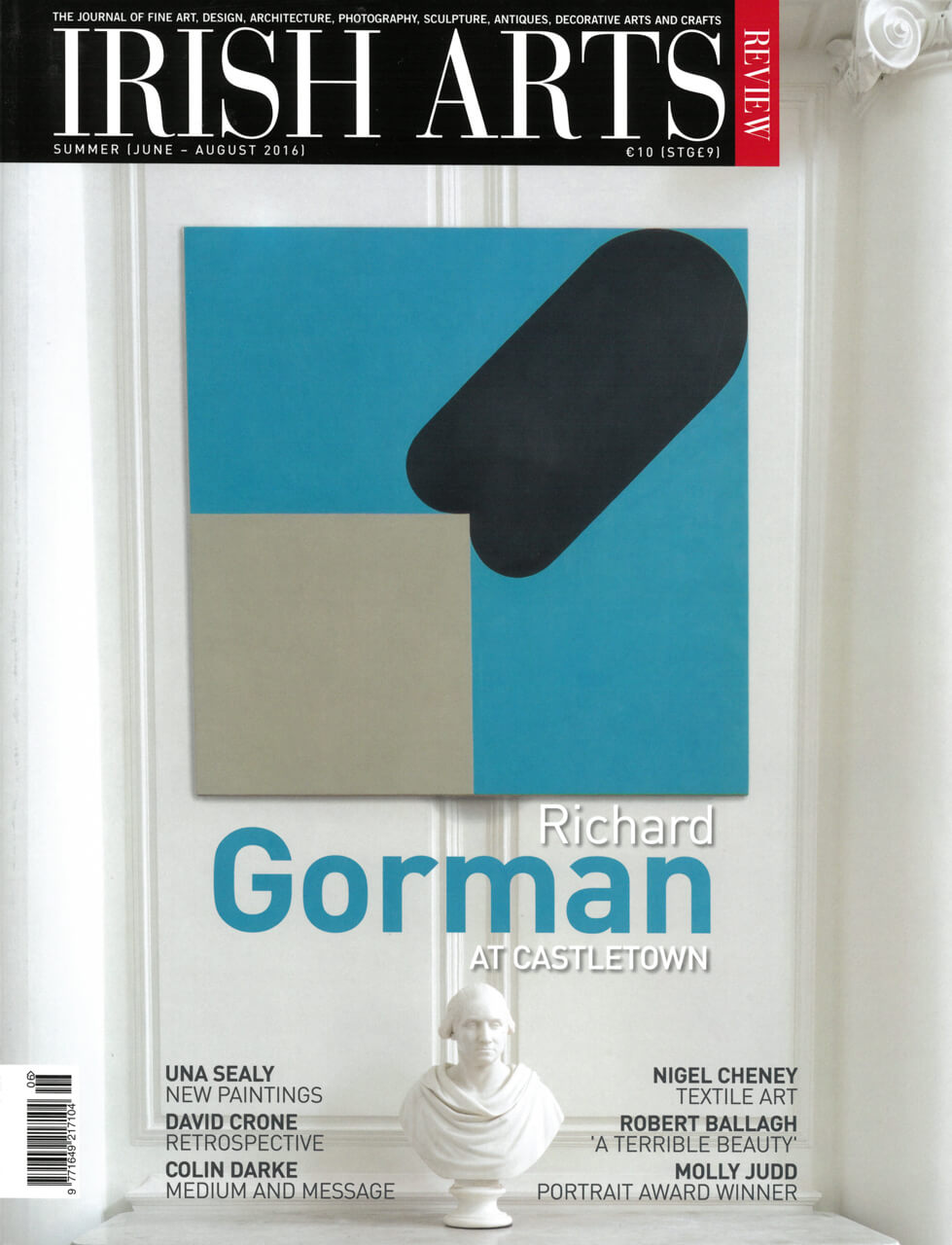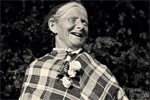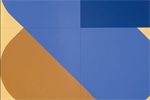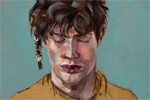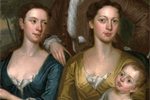
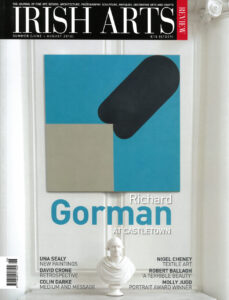
George Berkeley is famous for his contribution to philosophical thought, but less well known for his observations on art, some of which Peter Murray examines here.
In James Barry’s 1793 etching Lord Baltimore and the Legislators, one of a series of large prints based on Barry’s monumental mural cycle A Series of Paintings on Human Culture in the Royal Society of Arts, the philosopher George Berkeley (1685-1753) is depicted, sitting amongst a group of legislators, jurists and ecclesiastics. Barry based the idea for such an assembly partly on the writings of Berkeley’s friend and patron, Jonathan Swift. In Swift’s Gulliver’s Travels (1726), having landed on the island of Glubbrubdrib, Gulliver summons up the ghosts of political and intellectual leaders from the past, including Pierre Gassendi and René Descartes. Along with Malebranche, Locke, Hobbes and Leibnitz, these two were among the philosophers avidly read by Berkeley when a student at Trinity College. From them he learned the empirical approach that guided his own philosophical considerations throughout his life. In Barry’s etching, Berkeley sits close to a second group, a ‘Sextumvirate’ that includes Sir Thomas More, Marcus Brutus, Lucius Junius Brutus, Cato the Younger, Socrates and Epaminondas, while in Swift’s novel, this same group of men, considered paragons of moral and intellectual courage, materialize at Gulliver’s request. Such imagined congregations of intellectual and moral elites, in Barry’s paintings and in Swift’s writings, were very much part of Berkeley’s world, emerging from the discussions of his contemporaries, who debated issues of science, politics, philosophy and economics in the coffee-houses and academies of Europe. Barry’s drawing Passive Obedience, a political allegory, clearly refers to the book of the same title written by Berkeley in 1712, and gives an indication as to why both men were regarded with suspicion by the Whig political establishment in London, where the term ‘passive obedience’ hinted at disloyalty to Hanoverian rule.
After graduating from TCD in 1713, Berkeley, already celebrated as an original thinker, made his way to London and was introduced by Jonathan Swift to the literary circles of Queen Anne’s court. His main philosophical assertion, that what people were pleased to call reality, did not in fact exist, led to his acquiring a degree of notoriety and he was happy to discuss the nature of existence and perception with writers such as Addison and Steele. On Swift’s recommendation, Berkeley became chaplain and secretary to the Earl of Peterborough, a follower of Locke, who in 1713 was appointed Ambassador to Sicily. Berkeley made his first trip to Italy that same year, as aide to Peterborough. Two years later, another friend of Swift’s, St. George Ashe, (the Bishop alleged to have performed the secret marriage of Swift and ‘Stella’) asked Berkeley to accompany his son on a tour of the Continent. Little is known of Berkeley’s travels in 1716, but the following year he was in Naples, writing to Dr Arbuthnot a vivid and detailed description of an eruption of Vesuvius. His travels led him to Apulia and Calabria, but it was in Rome, in the palaces and churches of the Eternal City, that Berkeley chiefly found inspiration: ‘In the afternoon we went to the Villa Borghese. I liked the gardens, they are large, have fine cut walks, white deer, statues, fountains, groves; nothing of the little French gout, no parterres. . The house is noble, and hath the richest outside that I have anywhere seen, being enchased with beautiful relievos of antiquity. The portico was furnished with old chairs, very entire, being of hard stone, coloured red in some places and gilt in others, carved too with several devices. It was too dark to see the pictures, so we put off viewing the inside to another time’.
. . . Mr Hardy, the Abbate Barbieri, Mr Ashe, and I went this morning to see the famous Farnesian Palace. The gallery so much spoken of proved smaller than I expected, but the painting is excellent; it is all over done in fresco by Annibal Carache. Here and in other parts of the palace we saw several fine antique busts and statues. The principal are the Hercules, commonly called the Farnesian Hercules, the Flora, the bust of Caracalla, the flesh whereof is wonderfully soft and natural, and an admirable group of Zethus, Amphion, Antiope, Dirce, and a bull, all cut of one stone, done by two Rodians. 1
The visitors also viewed frescoes by Raphael and his followers in the loggia of the Vatican. In St Peter’s, Berkeley reckoned the Pietà by Michelangelo to be the best thing he had seen. They were impressed by the Pantheon, and the Jesuit church of St Ignatius, where Berkeley praised the illusionistic painting of Andrea Pozzo, whose ‘cupola is so represented by the same hand in perspective that it wonderfully deceives the eye as one walks towards it from the door along the great aisle.’2 Completed some twenty-five years before Berkeley’s visit to Rome, the ‘quadratura’ style of these paintings nonetheless affirmed some of the principles set out in his 1709 Essay Towards a New Theory of Vision, where he argued that people do not see ‘naturally’, but learn this skill from early childhood, and as a consequence their apprehension of reality is based upon a multiplicity of cues, including colour, shape, texture and line. The group visited the Capitoline Museum, admiring the antique sculpture of Marcus Aurelius on horseback, and the Palazzo Barberini:
‘Amongst the fine pictures here is an incomparable Madeleine of Guido Reni, reckoned the best piece that ever he did. The Madonna and Holy Family of Perugino is the most valuable piece of that painter that I have seen. His drapering every one knows to of a little gout [taste], and he knew nothing of the chiaro-oscuro. But for sweetness, grace, and beauty there is enough in this piece to render it admirable. I must not forget two excellent portraits, the one of Clara Famese by Gaetano, the other by Parmeginino : it is one head of four in a group, that which looks directly at you. It is perfect life.’3
The reverence for ancient Greece and Rome shared by Berkeley, Lord Charlemont and James Barry was nothing new. In the early 17th century, the 1st Earl of Cork’s sons had gone on a Grand Tour, while in 1714 it was the turn of the Earl’s descendant, Richard Boyle, 3rd Earl of Burlington, to follow an itinerary through Italy. Having studied the works of Vitruvius, and buildings such as the Villa Pisani and the Palazzo Pitti, he then returned London where he initiated the fashion for classical architecture, designing (along with Colen Campbell) Burlington House and Chiswick Villa. On his first trip, Burlington had been accompanied by the Huguenot Henry Isaac Gervais, later Vicar Choral of Lismore and a close friend of Berkeley’s.4
Later in the 18th century, Frederick Hervey, who succeeded Berkeley as Bishop of Cloyne, was to become perhaps the most famous of these ‘Grand Tourists’. Although Burlington and Berkeley were in Italy around the same time, they may not have met personally, although they later became firm friends. Berkeley was already friendly with another Cork grandee, Sir John Perceval, MP for Cork and later 1st Earl of Egmont, who had returned from his Grand Tour in 1707. Writing to Perceval from Trinity College on 22 September 1709, Berkeley sympathized regarding the seizure of Perceval’s artworks by the French authorities: ‘ . . I am sorry to hear from Dan Dering that you have lost your statues, medals, &c. that you had coming from Italy; though on second thoughts I almost doubt whether it may be reckoned a loss. Nobody purchases a cabinet of rarities to please himself with the continued light of them, nothing in it being of any farther use to the owner than as it entertains his friends; but I question if your neighbours in the county of Cork would relish that sort of entertainment. To feed their eyes with the sight of rusty medals and antique statues would (if I mistake not) seem to them something odd and insipid. The finest collection is not worth a groat where there is no one to admire and set a value on it, and our country seems to me the place in the world which is least furnished with virtuosi.’5 Almost a decade later, writing from Rome on 28 July 1718, Berkeley informed Perceval that he had bought a great number of prints of the churches, palaces and statues of the city. These included large prints of Trajan’s Column and the ‘Antonina’ (Column of Marcus Aurelius). However on showing these to a friend, Berkeley had been told that the prints were poor impressions, as the plates were worn out, so he returned them to the print-seller. The rest were packed and on board an English ship, ready to be delivered to Perceval, on whose behalf Berkeley was making these purchases.6
Berkeley also probably acquired works of art for his own collection, but seems to have concentrated mainly on buying books. After returning to England, in the 1720s he expended most of his own fortune, and the funds of others, attempting to set up a Protestant college in Bermuda. In 1726 he was obliged sell some paintings by Dutch artists; (they may have been works bequeathed to him by Esther Van Homrigh, ‘Vanessa’): ‘I shall take care the pictures be sold in an auction. Mr. Smibert, whom I know to be a very honest, skilful person in his profession, will see them put into an auction at the proper time, which he tells me is not till the town fills with company, about the meeting of parliament.’7 By February of the following year, the paintings had been sold, for forty-five pounds, at Covent Garden, ‘ . . at the house of one Mr. Russel, a painter. They were sold publicly and fairly among several other pictures. The truth of it is, that of late years the taste lies so much towards Italian pictures, many of which are daily imported, that Dutch pictures go off but heavily. Mr. Smibert did not think they would have brought so much.’8 The artist Smibert was Berkeley’s friend, and painted several portraits of him. Some of the proceeds of the sale went to a ‘Mr. Partington Van Homrigh’ in Ireland.
Berkeley then sailed to America, and spent some years living in Rhode Island, but saw his plans for the Bermuda project gradually evaporate. He returned to Ireland, and between 1734 and 1751 lived with his family near Midleton, Co Cork. As Bishop of Cloyne, he was active in local affairs, particularly in the promotion of religious observance, arts and industry. He encouraged linen manufacturing, papermaking, print-making and painting, and wrote on a range of topics including medicinal cures and economics. His book, The Querist, helped galvanize debate as to whether Ireland should seek independence from Britain. Amongst the queries relating to economics was one that considered the setting up of an art school: ‘Whether when a room was once prepared, and models in plaster of Paris, the annual expense of such an academy, need stand the public in above £200 a year?’9 Berkeley collected works of art, and encouraged his neighbours, such as the Earls of Shannon and Inchiquin, to do the same. In his 1750 account of Cork, Charles Smith recalls the paintings at Cloyne, including a Rubens’ Magdalen, as well as portrait ‘heads’ by Van Dyke and Kneller… ‘besides several good paintings performed in the house; an example so happy it has diffused itself into the adjacent gentlemen’s houses’. There were strawberries and raspberries in the gardens, and hedges of myrtle, six foot tall, planted by Berkeley himself, each having ‘a large ball of tar put to their roots’.10 A musician, Peter Pasquilino, was part of the Berkeley household, and taught the children to play the violoncello. Smith praised the Bishop’s views on the value of the arts: ‘The great usefulness of Design, in the manufacturers of stuffs, silks, diapers, damasks, tapestry, embroidery, earthen ware, sculpture, architecture, cabinet work, and an infinite number of such arts, is sufficiently evident.’11
Berkeley’s son William was an aspiring artist, as was his wife Anne, the daughter of John Forster, Attorney-General of Ireland. Paintings by Dutch and Italian artists were borrowed from Berkeley’s friend Thomas Prior, and copied at Cloyne by William and Anne. ‘My two younger children are beginning to employ themselves in the same way. In short, here are two or three families in Imokilly bent upon painting; and I wish it was more general among ladies and idle people as a thing that may divert the spleen, improve the manufactures and increase the wealth of the nation.’12 In February 1749, a box of paintings sent by Prior was delivered to Cloyne. Berkeley was delighted with the contents: ‘The two men’s heads with ruffs are well done; the third is a copy, and ill-coloured: they are all Flemish: so is the woman, which is also very well painted . . The two Dutch pictures, containing animals, are well done as to the animals: but the human figures and sky are ill done. The two pictures of ruins are very well done, and are Italian. My son William had already copied two other pictures of the same kind, and by the same hand. He and his sister are both employed in copying pictures at present.’13 However in 1751, William died unexpectedly, causing his father much grief. Berkeley then moved to Oxford, where he died after just one year. The Bishop was always practical in outlook, and indeed his philosophy was founded on a suspicion of words and language. He made the best of his time at Cloyne, although he wrote to Lady Burlington of being ‘haunted with a taste for good company and fine arts that I got at Burlington House, the worst preparative in the world for a retreat to Cloyne’.14
What became of the art collection assembled at Cloyne is not known. In 1796 Berkeley’s library was dispersed at auction and presumably any artworks were sold around the same time. The Sotheby’s catalogue for the library sale, reprinted in David Berman’s 1989 George Berkeley: Eighteenth Century Responses, lists hundreds of books, among them Roger de Piles Art of Painting, Pittura Antica nelle Terme di Tito, Imagini Depinte da Rafaelle d’Urbino and Da Vinci della Pittura. Another book that gives an insight into the Bishop’s knowledge of art was Vasari’s le Vite Pittori, Scultori et Architetti, printed in Bologna in 1647. What does survive of Berkeley’s time, in Ireland, London and America, is a series of portraits, several by Smibert, including examples in the National Gallery of Ireland, Trinity College (Fig 2) and Yale University (Fig 3). However, of the other works of art that formed part of Berkeley’s collection at Cloyne, no record has yet emerged.
Peter Murray is co-editor of Art and Architecture of Ireland, Vol V: The Twentieth Century, Yale/Royal Irish Academy (2014).
1 Berkeley ‘Italian Journals’ (1717) Works, pp515/517.
2 As note 1 p. 521.
3 As note 1 p. 524.
4 John Ingamells, A Dictionary of British and Irish Travellers in Italy 1701-1800 (Yale University Press, 1997) p. 160.
5 Benjamin Rand, The Correspondence of George Berkeley, afterward Bishop of Cloyne, and Sir John Percival, afterwards Earl of Egmont, Cambridge 1914, p. 57
6 As note 5 p. 172
7 Berkeley to Thomas Prior, 1 December 1726, quoted in Alexander Campbell Fraser Life and Letters of George Berkeley DD, Formerly Bishop of Cloyne, Vol. IV (MacMillan 1901) p140
8 Berkeley to Thomas Prior, 27 Feb. 1727, quoted in Works, pp. 141-2
9 George Berkeley, The Querist, 2 parts, Dublin 1725, Part I, p. 15, q. 71
10 Robert Day et al (ed.), Charles Smith, The Ancient and Present State of the County and City of Cork, (Cork 1893), p. 110
11 Charles Smith, The Antient and Present State of the County and City of Cork, 2 vols, Dublin 1750, vol. I, p. 147
12 Berkeley to Prior, 3 July 1746, in Works, Vol. IV, p. 309
13 As note 12, Berkeley to Prior 2 Feb 1749, p. 319.
14 Edward Chaney, The Evolution of the Grand Tour (London 1998), p.322.
